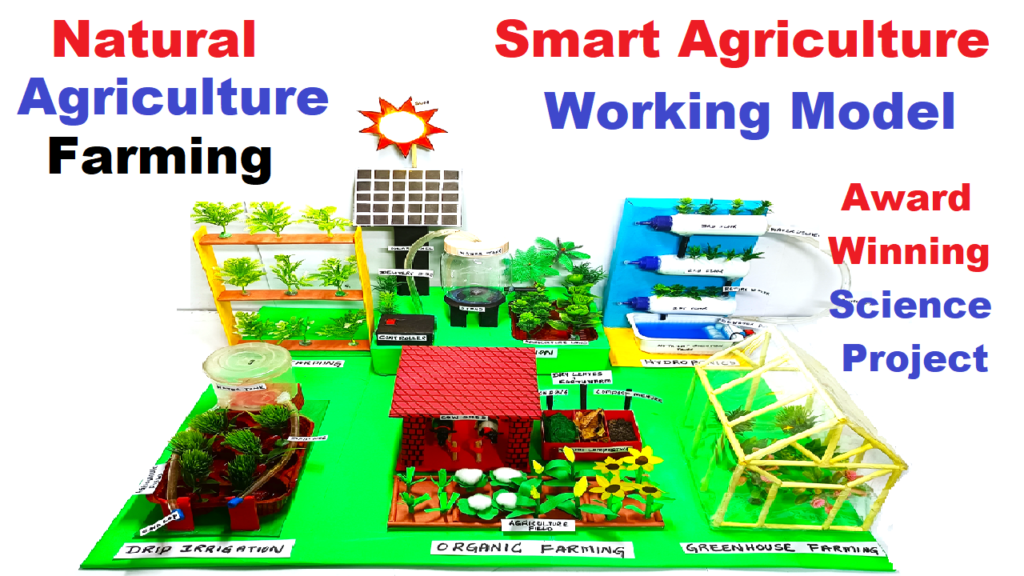Natural farming is an agricultural method that relies on nature’s processes to grow crops without using chemical fertilizers, pesticides, or intensive plowing. It focuses on soil health, biodiversity, and minimal human intervention, making it an eco-friendly and sustainable approach.

Here are 20 science working model ideas on Natural Farming for school exhibitions:
1. Zero Budget Natural Farming (ZBNF) Model
- A 3D model showing the principles of ZBNF, including Jeevamrutha, Bijamrita, Mulching, and Whapasa.
- Use small plants, natural fertilizers, and labels to explain the process.
2. Rainwater Harvesting for Natural Farming
- Create a miniature farm with a rainwater collection system.
- Show how rainwater is stored and used for irrigation.
3. Drip Irrigation Model
- Demonstrate water-efficient farming using a drip irrigation system with pipes and small holes to water plants.
- Use a bottle as a water tank and small tubes for irrigation.
4. Vermicomposting Model
- Build a vermicompost bin using earthworms and organic waste to show how natural compost is made.
- Use a glass box to make the layers of compost visible.
5. Organic vs Chemical Farming Comparison Model
- Create two identical plant setups: one with organic farming (cow dung, compost) and one with chemical fertilizers.
- Show differences in plant growth, soil health, and pest resistance.
6. Crop Rotation and Soil Health Model
- Use a rotating wheel or layered farm model to explain how different crops improve soil nutrients.
- Example: Legumes (nitrogen-fixing) followed by grains.
7. Mulching and Soil Moisture Retention Model
- Show how mulching (straw, leaves, or paper) prevents water loss in soil.
- Compare mulched and non-mulched soil in containers.
8. Biogas Plant Model from Farm Waste
- Demonstrate how cow dung and organic waste from farms can be converted into biogas for cooking and electricity.
- Use a balloon to show gas collection.
9. Hydroponic Natural Farming Model
- Create a soilless farming model using water, nutrients, and small plant holders.
- Show how hydroponics reduces land usage and conserves water.
10. Natural Pest Control Model
- Show different natural pest control methods like neem oil spray, marigold plants for repelling insects, and companion planting.
- Create sections with various organic pest control techniques.
11. Water Conservation Using Whapasa Model
- Show how minimal water use in farming can keep the soil moist by covering soil with organic matter.
- Compare dry soil vs. soil treated with Whapasa techniques.
12. Panchagavya as a Natural Fertilizer Model
- Demonstrate how Panchagavya (cow dung, urine, milk, curd, ghee) helps plant growth.
- Use different plants to show the effects of natural fertilizers.
13. Agnihotra Farming Model
- Show how Agnihotra (fire ceremony) in farming improves soil and air quality.
- Create a small fire pit model and plant section to compare effects.
14. Wastewater Recycling for Natural Farming
- Demonstrate how household greywater (from washing) can be filtered and reused in farming.
- Use a filtration system with sand, gravel, and activated charcoal.
15. Greenhouse Model for Organic Farming
- Create a mini greenhouse using transparent plastic or glass.
- Show how it helps grow organic vegetables year-round.
16. Integrated Farming System Model
- Demonstrate a farm where crops, livestock, fish, and poultry work together for sustainability.
- Example: A duck pond where ducks eat pests, and water is used for irrigation.
17. Fukuoka’s Natural Farming (No-Till Farming) Model
- Show how seeds are directly scattered on the ground with no plowing.
- Compare a tilled field vs. a no-till farming setup.
18. Biodynamic Farming Model
- Explain how lunar cycles and organic preparations affect plant growth.
- Use a rotating moon phase model to show planting cycles.
19. Organic Kitchen Garden Model
- Create a small organic vegetable garden model showing how compost, rainwater, and natural pest repellents help.
- Use real or artificial plants.
20. Food Forest Model
- Show how a natural multi-layer farming system mimics a forest for sustainable agriculture.
- Include tall trees (coconuts), medium trees (bananas), shrubs (tomatoes), and ground cover (spinach).
Conclusion
These working models help demonstrate the importance of natural farming in a hands-on way. You can choose a project based on your materials and time availability.

